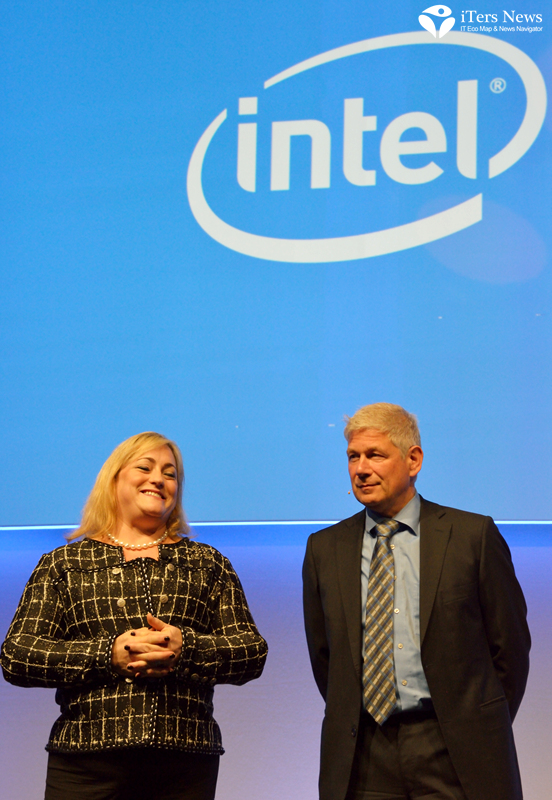(iTers News) - Intel Corporation sketched out its mobile computing platform technology roadmap for mainstream smart phones and Internet of Things devices, emphasizing that all Intel’s future-proof mobile CPUs are well optimized for 64-bit mobile computing era.
The computing chip giant also detailed its LTE baseband chip solutions, one leg of its mobile computing platform strategy.
At a press conference here held at MWC 2014 in Barcelona, Spain, Intel’s president Renee James said, “"Sixty-four bit computing is moving from the desktop to the mobile devices." She added, “Intel knows 64-bit computing, and we're the only company currently shipping 64-bit processors supporting multiple operating systems today, and capable of supporting 64-bit Android when it is available.”
Intel has also delivered 64-bit kernels across operating systems, so customers who choose Intel Atom have a ready foundation for a 64-bit experience as the operating system and applications evolve.
Intel’s immediate mass-rollout for the 64-bit computing is Atom Z3480 codenamed Merrifield that comes with two Silvermont processor cores of a maximum turbo frequency of 2.13GHz.
64-bit Roadmap
Fabricated with its 22nm chip design technology, the Merrifield comes with Imagination Technologies’ PowerVR Series 6 Graphics IP core.
The Merrifield pairs with Intel XMM7160 LTE baseband chip solution on a package level to drum up itself as a mobile computing and communications platform
The Merrifield is the first Intel Atom SoC to feature the new Intel’s Integrated Sensor Solution, which efficiently manages sensor data to keep applications smart and contextually aware even when the device is in a low-power state in what’ s called s perceptive computing.
It also comes with a dual channel LPDDR3 1066 MT/s memory interface with a maximum bandwidth of 17GB/s and dedicated video and image signal processors.
Intel expects Merrifield-based devices from multiple OEMs to launch beginning in the second quarter.
Intel has one more up its sleeve- codename Moorefield. As the global smartphone market is rapidly getting polarized between high-end and low-cost models, Intel is working on an upgrade on the Merrifield.
Scheduled to debut in the second half of the year, the Moorefield adds two additional Intel architecture cores for up to 2.3GHz of compute performance, an enhanced GPU and support for faster memory. For example, its memory bandwidth marks a significant 50% improvement, climbing its way up from Merrifield’s LPDDR3 1066MT/s to LPDDR3 1600MT/s, or a whoppoing25GB/s. It comes embedded with quad cores, boasting 2.3GHz. The Moorefield is optimized for Intel's 2014 LTE platform, the Intel XMM 7260.
The Intel XMM LTE baseband series are the most important technology enabler for Intel’s foray into smart phone arena.
The Intel XMM 7260 delivers competitive LTE-Advanced capabilities including carrier aggregation that supports 23 CA combinations in a single chip. It sports category 6 speeds and is backward-compatible with TDD LTE and TD-SCDMA, which allows it to address legacy market.
Intel’s 7260 LTE-A baseband chip demonstrates a peak LTE-Advanced Category 6 data rates of simultaneous 300Mbps downlink and 50Mbps uplink with carrier aggregation technology.
The 7260 builds on Intel's competitive Intel XMM 7160 platform.
Now certified to run on 70% of LTE networks worldwide, the 7160 is expanding to connect a range of products spanning smartphones, tablets, 2 in 1s, Ultrabook systems and beyond.
Customers currently shipping or planning to launch devices featuring Intel's LTE platforms include Acer, ASUS, Dell, Lenovo and Samsung, among others.
Set standards for IoTs
"We are entering 2014 with a very competitive mobile portfolio spanning application processors and communications platforms that will only get stronger," said Hermann Eul, vice president and general manager of Intel's Mobile and Communications Group.
"Our new Atom processors for Android smartphones and tablets offer leading 64-bit performance and battery life, and the new 7260 platform gives the ecosystem a compelling LTE-Advanced experience."
For example, Intel and Lenovo announced plans to introduce new Intel-based mobile devices this year, including K900 smartphone, Yoga line of multimode laptops, MIIX 2 and ThinkPad 8 tablets.
Additionally, ASUS announced it will bring a full portfolio of Intel-based smartphones and tablets to market this year. The company has recently introduced its ZenFone line of smartphones and the unique PadFone mini, both of which feature Intel processors and communications platforms.
ASUS’s Fonepad 7 LTE comes built with Intel Atom processor and Intel LTE connectivity, for example.
Foxconn and Intel are teaming up to drive the broader, global availability of high-quality, affordable Intel-based Android tablets. Intel will provide Intel Atom processors and communications platforms for a range of Foxconn products, beginning with tablets, this year.
Expanded ecosystem
The explosion of mobile devices and rapid growth in the Internet of Things is driving transformation of the network infrastructure to meet increasing demand for more connectivity and real-time data. Intel is enabling this transformation by delivering standardized hardware and software that apply open standards and high-volume economics to help reduce costs, while accelerating the delivery of new services, capabilities and revenue models for service providers.
In an effort to bring the benefits of a standards-based approach to communications networks consistent with Intel's work in data centers and the cloud, Intel will work with Alcatel-Lucent and Cisco on a much boarder relationship to accelerate network function virtualization (NFV) and software defined network (SDN) technologies.
By working to optimize these technologies on IA, service providers will be offered a faster and more flexible network that enables them to quickly scale new services.
(Photos and Videos by JH Bae)







